Long-Term and Seasonal Analysis of Storm-Wave Events in the Gulf of California
Abstract
1. Introduction
2. Site Study
3. Methodology
3.1. Offshore Wave Data
3.2. Analysis of Storm-Wave Events
3.3. Spatial Assessment of Storm-Wave Events
3.4. Temporal Assessment of Storm-Wave Events
4. Results
4.1. General Description of Wave Heights
4.2. Spatial Variability of Storm-Wave Events
4.3. Temporal Variability of Storm-Wave Events
5. Discussion
6. Conclusions
Author Contributions
Funding
Data Availability Statement
Acknowledgments
Conflicts of Interest
References
- Yin, J.; Gentine, P.; Zhou, S.; Sullivan, S.C.; Wang, R.; Zhang, Y.; Guo, S. Large Increase in Global Storm Runoff Extremes Driven by Climate and Anthropogenic Changes. Nat. Commun. 2018, 9, 4389. [Google Scholar] [CrossRef] [PubMed]
- Laino, E.; Iglesias, G. Extreme Climate Change Hazards and Impacts on European Coastal Cities: A Review. Renew. Sustain. Energy Rev. 2023, 184, 113587. [Google Scholar] [CrossRef]
- Mousavi, M.E.; Irish, J.L.; Frey, A.E.; Olivera, F.; Edge, B.L. Global Warming and Hurricanes: The Potential Impact of Hurricane Intensification and Sea Level Rise on Coastal Flooding. Clim. Chang. 2011, 104, 575–597. [Google Scholar] [CrossRef]
- Yasuhara, K.; Komine, H.; Yokoki, H.; Suzuki, T.; Mimura, N.; Tamura, M.; Chen, G. Effects of Climate Change on Coastal Disasters: New Methodologies and Recent Results. Sustain. Sci. 2011, 6, 219–232. [Google Scholar] [CrossRef]
- Walsh, K.J.E.; McInnes, K.L.; McBride, J.L. Climate Change Impacts on Tropical Cyclones and Extreme Sea Levels in the South Pacific—A Regional Assessment. Glob. Planet. Chang. 2012, 80–81, 149–164. [Google Scholar] [CrossRef]
- Fernandino, G.; Elliff, C.I.; Silva, I.R. Ecosystem-Based Management of Coastal Zones in Face of Climate Change Impacts: Challenges and Inequalities. J. Environ. Manag. 2018, 215, 32–39. [Google Scholar] [CrossRef] [PubMed]
- Adamopoulos, I.; Frantzana, A.; Syrou, N. Climate Crises Associated with Epidemiological, Environmental, and Ecosystem Effects of a Storm: Flooding, Landslides, and Damage to Urban and Rural Areas (Extreme Weather Events of Storm Daniel in Thessaly, Greece). Med. Sci. Forum 2024, 25, 7. [Google Scholar] [CrossRef]
- Dutta Roy, A.; Karpowicz, D.A.; Hendy, I.; Rog, S.M.; Watt, M.S.; Reef, R.; Broadbent, E.N.; Asbridge, E.F.; Gebrie, A.; Ali, T.; et al. Current Status of Remote Sensing for Studying the Impacts of Hurricanes on Mangrove Forests in the Coastal United States. Remote Sens. 2024, 16, 3596. [Google Scholar] [CrossRef]
- Solano, C.L.; Turki, E.I.; Hamdi, Y.; Soloy, A.; Costa, S.; Laignel, B.; Barceló, Á.D.G.; Abcha, N.; Jacono, D.; Lafite, R. Dynamics of Nearshore Waves during Storms: Case of the English Channel and the Normandy Coasts. Water 2022, 14, 321. [Google Scholar] [CrossRef]
- Ian, V.K.; Tse, R.; Tang, S.K.; Pau, G. Bridging the Gap: Enhancing Storm Surge Prediction and Decision Support with Bidirectional Attention-Based LSTM. Atmosphere 2023, 14, 1082. [Google Scholar] [CrossRef]
- Skliris, N.; Marsh, R.; Srokosz, M.; Aksenov, Y.; Rynders, S.; Fournier, N. Assessing Extreme Environmental Loads on Offshore Structures in the North Sea from High-Resolution Ocean Currents, Waves and Wind Forecasting. J. Mar. Sci. Eng. 2021, 9, 1052. [Google Scholar] [CrossRef]
- Franco-Ochoa, C.; Zambrano-Medina, Y.; Plata-Rocha, W.; Monjardín-Armenta, S.; Rodríguez-Cueto, Y.; Escudero, M.; Mendoza, E. Long-Term Analysis of Wave Climate and Shoreline Change along the Gulf of California. Appl. Sci. 2020, 10, 8719. [Google Scholar] [CrossRef]
- Ian, V.K.; Tang, S.K.; Pau, G. Assessing the Risk of Extreme Storm Surges from Tropical Cyclones under Climate Change Using Bidirectional Attention-Based LSTM for Improved Prediction. Atmosphere 2023, 14, 1749. [Google Scholar] [CrossRef]
- Mendoza, E.T.; Jimenez, J.A.; Mateo, J. A Coastal Storms Intensity Scale for the Catalan Sea (NW Mediterranean). Nat. Hazards Earth Syst. Sci. 2011, 11, 2453–2462. [Google Scholar] [CrossRef]
- Mendoza, E.T.; Jiménez, J.A. Classification of Coastal Storms for the Catalan Coast (NW Mediterranean). Ing. Hidraul. En Mex. 2008, 23, 21–32. [Google Scholar]
- Mendoza, E.T.; Jiménez, J.A. Storm-Induced Erosion Potential on the Catalonian Coast. J. Coast. Res. 2006, 81–88. [Google Scholar]
- Saviano, S.; Biancardi, A.A.; Uttieri, M.; Zambianchi, E.; Cusati, L.A.; Pedroncini, A.; Contento, G.; Cianelli, D. Sea Storm Analysis: Evaluation of Multiannual Wave Parameters Retrieved from HF Radar and Wave Model. Remote Sens. 2022, 14, 1696. [Google Scholar] [CrossRef]
- Elahi, M.W.E.; Wang, X.H.; Salcedo-Castro, J.; Ritchie, E.A. Influence of Wave–Current Interaction on a Cyclone-Induced Storm Surge Event in the Ganges–Brahmaputra–Meghna Delta: Part 1—Effects on Water Level. J. Mar. Sci. Eng. 2023, 11, 328. [Google Scholar] [CrossRef]
- Dhoop, T.; Mason, T. Spatial Characteristics and Duration of Extreme Wave Events around the English Coastline. J. Mar. Sci. Eng. 2018, 6, 14. [Google Scholar] [CrossRef]
- Santos, V.M.; Haigh, I.D.; Wahl, T. Spatial and Temporal Clustering Analysis of Extreme Wave Events around the UK Coastline. J. Mar. Sci. Eng. 2017, 5, 28. [Google Scholar] [CrossRef]
- Shaw, T.A.; Baldwin, M.; Barnes, E.A.; Caballero, R.; Garfinkel, C.I.; Hwang, Y.T.; Li, C.; O’Gorman, P.A.; Rivière, G.; Simpson, I.R.; et al. Storm Track Processes and the Opposing Influences of Climate Change. Nat. Geosci. 2016, 9, 656–664. [Google Scholar] [CrossRef]
- Wu, X.; Yuan, T.; Qie, K.; Luo, J. Geographical Distribution of Extreme Deep and Intense Convective Storms on Earth. Atmos. Res. 2020, 235, 104789. [Google Scholar] [CrossRef]
- Ortiz-Royero, J.C.; Otero, L.J.; Restrepo, J.C.; Ruiz, J.; Cadena, M. Cold Fronts in the Colombian Caribbean Sea and Their Relationship to Extreme Wave Events. Nat. Hazards Earth Syst. Sci. 2013, 13, 2797–2804. [Google Scholar] [CrossRef]
- O’Shea, D.; Nathan, R.; Wasko, C.; Sharma, A. Separating Storm Intensity and Arrival Frequency in Nonstationary Rainfall Frequency Analysis. Water Resour. Res. 2024, 60, e2023WR036165. [Google Scholar] [CrossRef]
- Collalti, D.; Spencer, N.; Strobl, E. Flash Flood Detection via Copula-Based Intensity-Duration-Frequency Curves: Evidence from Jamaica. Nat. Hazards Earth Syst. Sci. 2024, 24, 873–890. [Google Scholar] [CrossRef]
- Ghanbari, M.; Dell, T.; Saleh, F.; Chen, Z.; Cherrier, J.; Colle, B.; Hacker, J.; Madaus, L.; Orton, P.; Arabi, M. Compounding Effects of Changing Sea Level and Rainfall Regimes on Pluvial Flooding in New York City. Nat. Hazards 2024, 120, 6377–6400. [Google Scholar] [CrossRef]
- Shi, X.; Liu, Y.; Chen, J.; Chen, H.; Wang, Y.; Lu, Z.; Wang, R.Q.; Fung, J.C.H.; Ng, C.W.W. Escalating Tropical Cyclone Precipitation Extremes and Landslide Hazards in South China under Global Warming. Npj Clim. Atmos. Sci. 2024, 7, 107. [Google Scholar] [CrossRef]
- Laiho, R.; Friedrich, K.; Winters, A.C. Synoptic-Scale Meteorological Patterns Associated with Heavy Rainfall in the Minnesota Region. J. Appl. Meteorol. Clim. 2024, 63, 837–854. [Google Scholar] [CrossRef]
- Chowdhury, P.; Lakku, N.K.G.; Lincoln, S.; Seelam, J.K.; Behera, M.R. Climate Change and Coastal Morphodynamics: Interactions on Regional Scales. Sci. Total Environ. 2023, 899, 166432. [Google Scholar] [CrossRef] [PubMed]
- Amarouche, K.; Akpınar, A.; Semedo, A. Wave Storm Events in the Western Mediterranean Sea over Four Decades. Ocean Model. 2022, 170, 101933. [Google Scholar] [CrossRef]
- Amarouche, K.; Akpınar, A.; Çakmak, R.E.; Houma, F.; Bachari, N.E.I. Assessment of Storm Events along the Algiers Coast and Their Potential Impacts. Ocean Eng. 2020, 210, 107432. [Google Scholar] [CrossRef]
- Kutupoğlu, V.; Çalışır, E.; Akpınar, A. Characterization and Classification of Wave Storm Events and Wave Climate on the Sea of Marmara. Ocean Eng. 2023, 279, 114448. [Google Scholar] [CrossRef]
- Bernardino, M.; Rusu, L.; Guedes Soares, C. Evaluation of Extreme Storm Waves in the Black Sea. J. Oper. Oceanogr. 2021, 14, 114–128. [Google Scholar] [CrossRef]
- Ojeda, E.; Appendini, C.M.; Mendoza, E.T. Storm-Wave Trends in Mexican Waters of the Gulf of Mexico and Caribbean Sea. Nat. Hazards Earth Syst. Sci. 2017, 17, 1305–1317. [Google Scholar] [CrossRef]
- de Lima, A.d.S.; Khalid, A.; Miesse, T.W.; Cassalho, F.; Ferreira, C.; Scherer, M.E.G.; Bonetti, J. Hydrodynamic and Waves Response during Storm Surges on the Southern Brazilian Coast: A Hindcast Study. Water 2020, 12, 3538. [Google Scholar] [CrossRef]
- De Leo, F.; Briganti, R.; Besio, G. Trends in Ocean Waves Climate within the Mediterranean Sea: A Review. Clim. Dyn. 2024, 62, 1555–1566. [Google Scholar] [CrossRef]
- Ananthu, P.; Shanas, P.R.; Komath, S.; Sivakrishnan, K.K.; Kumar, V.S. Wave Climate of Kerala Coast: An 83-Year ERA-5 Study of Trends and Seasonality. Earth Syst. Environ. 2025, 1–22. [Google Scholar] [CrossRef]
- Li, D.; Feng, J.; Zhu, Y.; Staneva, J.; Qi, J.; Behrens, A.; Lee, D.; Min, S.K.; Yin, B. Dynamical Projections of the Mean and Extreme Wave Climate in the Bohai Sea, Yellow Sea and East China Sea. Front. Mar. Sci. 2022, 9, 844113. [Google Scholar] [CrossRef]
- Ranasinghe, R. Assessing Climate Change Impacts on Open Sandy Coasts: A Review. Earth Sci. Rev. 2016, 160, 320–332. [Google Scholar] [CrossRef]
- Eichentopf, S.; Karunarathna, H.; Alsina, J.M. Morphodynamics of Sandy Beaches under the Influence of Storm Sequences: Current Research Status and Future Needs. Water Sci. Eng. 2019, 12, 221–234. [Google Scholar] [CrossRef]
- Neumann, B.; Vafeidis, A.T.; Zimmermann, J.; Nicholls, R.J. Future Coastal Population Growth and Exposure to Sea-Level Rise and Coastal Flooding—A Global Assessment. PLoS ONE 2015, 10, e0131375. [Google Scholar] [CrossRef] [PubMed]
- Small, C.; Nicholls, R.J. A Global Analysis of Human Settlement in Coastal Zones. J. Coast. Res. 2003, 19, 584–599. [Google Scholar] [CrossRef]
- Hamid, A.I.A.; Din, A.H.M.; Abdullah, N.M.; Yusof, N.; Hamid, M.R.A.; Shah, A.M. Exploring Space Geodetic Technology for Physical Coastal Vulnerability Index and Management Strategies: A Review. Ocean Coast. Manag. 2021, 214, 105916. [Google Scholar] [CrossRef]
- Bernal, G.; Ripa, P.; Herguera, J.C. Oceanographic and Climatic Variability in the Lower Gulf of California: Links with the Tropics and North Pacific. Cienc. Mar. 2001, 27, 595–617. [Google Scholar] [CrossRef]
- Páez-Osuna, F.; Sanchez-Cabeza, J.A.; Ruiz-Fernández, A.C.; Alonso-Rodríguez, R.; Piñón-Gimate, A.; Cardoso-Mohedano, J.G.; Flores-Verdugo, F.J.; Carballo, J.L.; Cisneros-Mata, M.A.; Álvarez-Borrego, S. Environmental Status of the Gulf of California: A Review of Responses to Climate Change and Climate Variability. Earth Sci. Rev. 2016, 162, 253–268. [Google Scholar] [CrossRef]
- Lluch-Cota, S.E.; Tripp-Valdez, M.; Lluch-Cota, D.B.; Lluch-Belda, D.; Verbesselt, J.; Herrera-Cervantes, H.; Bautista-Romero, J.J. Recent Trends in Sea Surface Temperature off Mexico. Atmosfera 2013, 26, 537–546. [Google Scholar] [CrossRef]
- Vellanoweth, R.L.; Porcayo-Michelini, A.; Guttenberg, R.B.; Hayden, W.; Ainis, A.F.; Hernández-Estrada, R.L. Spring Tides, Storm Surges, and the Destruction of Coastal Middens: A Case Study from the Upper Gulf of California, México. J. Isl. Coast. Archaeol. 2020, 17, 420–431. [Google Scholar] [CrossRef]
- Odériz, I.; Silva, R.; Mortlock, T.R.; Mendoza, E. Climate Drivers of Directional Wave Power on the Mexican Coast. Ocean Dyn. 2020, 70, 1253–1265. [Google Scholar] [CrossRef]
- Dee, D.P.; Uppala, S.M.; Simmons, A.J.; Berrisford, P.; Poli, P.; Kobayashi, S.; Andrae, U.; Balmaseda, M.A.; Balsamo, G.; Bauer, P.; et al. The ERA-Interim Reanalysis: Configuration and Performance of the Data Assimilation System. Q. J. R. Meteorol. Soc. 2011, 137, 553–597. [Google Scholar] [CrossRef]
- Marinone, S.G. A Three-Dimensional Model of the Mean and Seasonal Circulation of the Gulf of California. J. Geophys. Res. Oceans 2003, 108. [Google Scholar] [CrossRef]
- Kasper-Zubillaga, J.J.; Carranza-Edwards, A.; Morales De la Garza, E. Textural Characterization of Beach Sands from the Gulf of California, Mexico: Implications for Coastal Processes and Relief. Cienc. Mar. 2007, 33, 83–94. [Google Scholar] [CrossRef]
- Lluch-Cota, S.E.; Aragón-Noriega, E.A.; Arreguín-Sánchez, F.; Aurioles-Gamboa, D.; Jesús Bautista-Romero, J.; Brusca, R.C.; Cervantes-Duarte, R.; Cortés-Altamirano, R.; Del-Monte-Luna, P.; Esquivel-Herrera, A.; et al. The Gulf of California: Review of Ecosystem Status and Sustainability Challenges. Prog. Oceanogr. 2007, 73, 1–26. [Google Scholar] [CrossRef]
- Morales-Perez, R.; Gutierrez De Velasco, G. Tides in the Gulf of California. Geofis. Int. 1989, 28-1, 25–46. [Google Scholar] [CrossRef]
- National Tidal Service. The Tides of Mexico; 2022; Available online: http://www.mareografico.unam.mx/ (accessed on 25 November 2022).
- Lluch-Cota, S.E.; Parés-Sierra, A.; Magaña-Rueda, V.O.; Arreguín-Sánchez, F.; Bazzino, G.; Herrera-Cervantes, H.; Lluch-Belda, D. Changing Climate in the Gulf of California. Prog. Oceanogr. 2010, 87, 114–126. [Google Scholar] [CrossRef]
- Moore, N.H.; Slinn, D.J. The Physical Hydrology of a Lagoon System on the Pacific Coast of Mexico. Estuar. Coast. Shelf Sci. 1984, 19, 413–426. [Google Scholar] [CrossRef]
- Ponce Bastidas, J.S. Coastal Dynamics in El Cardonal and Cabo Pulmo Beaches, Baja California Sur; National Polytechnic Institute: Mexico City, Mexico, 2015. [Google Scholar]
- Mart, B.S. Morphology and Sediments of the Beaches of the Coastal Cell of San Jose Del Cabo BCS Mexico; Autonomous University of Baja California Sur: La Paz, Mexico, 2018. [Google Scholar]
- Shao, Z.; Liang, B.; Li, H.; Lee, D. Study of Sampling Methods for Assessment of Extreme Significant Wave Heights in the South China Sea. Ocean Eng. 2018, 168, 173–184. [Google Scholar] [CrossRef]
- Amarouche, K.; Akpinar, A. Increasing Trend on Storm Wave Intensity in the Western Mediterranean. Climate 2021, 9, 11. [Google Scholar] [CrossRef]
- US Army Coastal Engineering Research Center. Shore Protection Manual; U.S. Government Printing Research Center: Washington, DC, USA, 1984. [Google Scholar]
- Dolan, R.; Davis, R. An Intensity Scale for Atlantic Coast Northeast Storms. J. Coast. Res. 1992, 8, 840–853. [Google Scholar]
- Mann, H.B. Non-Parametric Test Against Trend. Econometrica 1945, 13, 245–259. [Google Scholar] [CrossRef]
- Kendall, M.G. Rank Correlation Methods; Griffin: Oxford, UK, 1975. [Google Scholar]
- Reguero, B.G.; Losada, I.J.; Méndez, F.J. A Recent Increase in Global Wave Power as a Consequence of Oceanic Warming. Nat. Commun. 2019, 10, 205. [Google Scholar] [CrossRef]
- Vieira, F.; Cavalcante, G.; Campos, E. Analysis of Wave Climate and Trends in a Semi-Enclosed Basin (Persian Gulf) Using a Validated SWAN Model. Ocean Eng. 2020, 196, 106821. [Google Scholar] [CrossRef]
- Carrillo-carrillo, M.; Ibáñez-castillo, L.; Arteaga-ramírez, R. Spatio-Temporal Analysis of Drought with SPEI in the State of Mexico and Mexico City. Atmosphere 2025, 16, 202. [Google Scholar] [CrossRef]
- Bergeron, T. On the Physics of Fronts. Bull. Am. Meteorol. Soc. 1937, 18, 265–275. [Google Scholar] [CrossRef]
- Shanas, P.R.; Aboobacker, V.M.; Albarakati, A.M.M.A.; Zubier, K.M.M. Climate Driven Variability of Wind-Waves in the Red Sea. Ocean Model. 2017, 119, 105–117. [Google Scholar] [CrossRef]
- Aydoğan, B.; Ayat, B. Spatial Variability of Long-Term Trends of Significant Wave Heights in the Black Sea. Appl. Ocean Res. 2018, 79, 20–35. [Google Scholar] [CrossRef]
- Jury, M.R. A Survey of African Weather and Climate Extremes. Climate 2024, 12, 65. [Google Scholar] [CrossRef]
- Palacios-Hernández, E.; Montes-Aréchiga, J.M.; Brito-Castillo, L.; Carrillo, L.; Julián-Caballero, S.; Avalos-Cueva, D. Interannual Variability in the Coastal Zones of the Gulf of California. Climate 2023, 11, 132. [Google Scholar] [CrossRef]
- Cavazos, T.; Luna-Niño, R.; Cerezo-Mota, R.; Fuentes-Franco, R.; Méndez, M.; Pineda Martínez, L.F.; Valenzuela, E. Climatic Trends and Regional Climate Models Intercomparison over the CORDEX-CAM (Central America, Caribbean, and Mexico) Domain. Int. J. Climatol. 2020, 40, 1396–1420. [Google Scholar] [CrossRef]
- Mantua, N.J.; Hare, S.R. The Pacific Decadal Oscillation. J. Oceanogr. 2002, 58, 35–44. [Google Scholar] [CrossRef]
- Pavia, E.G.; Graef, F.; Reyes, J. Notes and Correspondence PDO—ENSO Effects in the Climate of Mexico. J. Clim. 2006, 19, 6433–6438. [Google Scholar] [CrossRef]
- Johnson, B.O.; Delworth, T.L. The Role of the Gulf of California in the North American Monsoon. J. Clim. 2023, 36, 1541–1559. [Google Scholar] [CrossRef]
- Herrera-Cervantes, H.; Lluch-Cota, D.B.; Lluch-Cota, S.E.; Gutiérrez-de-Velasco S, G. The ENSO Signature in Sea-Surface Temperature in the Gulf of California. J. Mar. Res. 2007, 65, 589–605. [Google Scholar] [CrossRef]
- Mooney, H.A.; Canadell, J.G.; Munn, R.E. Encyclopedia of Global Environmental Change, Volume 2, The Earth System: Biological and Ecological Dimensions of Global Environmental Chang; Wiley: Hoboken, NJ, USA, 2002; ISBN 0471977969. [Google Scholar]
- Rodríguez-Moreno, V.M.; Ruíz-Corral, J.A.; Medina-García, G.; Padilla-Ramírez, J.S.; Gunter Kretzschmar, T. Effect of the ENSO Condition in the Frequency and Intensity of Rainfall in the Baja California Peninsula (1998–2012). Rev. Mex. De Cienc. Agric. 2014, 10, 1923–1937. [Google Scholar]
- Odériz, I.; Silva, R.; Mortlock, T.R.; Mori, N. El Niño-Southern Oscillation Impacts on Global Wave Climate and Potential Coastal Hazards. J. Geophys. Res. Oceans 2020, 125, e2020JC016464. [Google Scholar] [CrossRef]
- Newman, M.; Compo, G.P.; Alexander, M.A. ENSO-Forced Variability of the Pacific Decadal Oscillation. J. Clim. 2003, 16, 3853–3857. [Google Scholar] [CrossRef]
- Durán-Quesada, A.M.; Sorí, R.; Ordoñez, P.; Gimeno, L. Climate Perspectives in the Intra-Americas Seas. Atmosphere 2020, 11, 959. [Google Scholar] [CrossRef]
- Martinez-Sanchez, J.N.; Cavazos, T. Eastern Tropical Pacific Hurricane Variability and Landfalls on Mexican Coasts. Clim. Res. 2014, 58, 221–234. [Google Scholar] [CrossRef]
- Thornton, P.K.; Ericksen, P.J.; Herrero, M.; Challinor, A.J. Climate Variability and Vulnerability to Climate Change: A Review. Glob. Chang. Biol. 2014, 20, 3313–3328. [Google Scholar] [CrossRef] [PubMed]
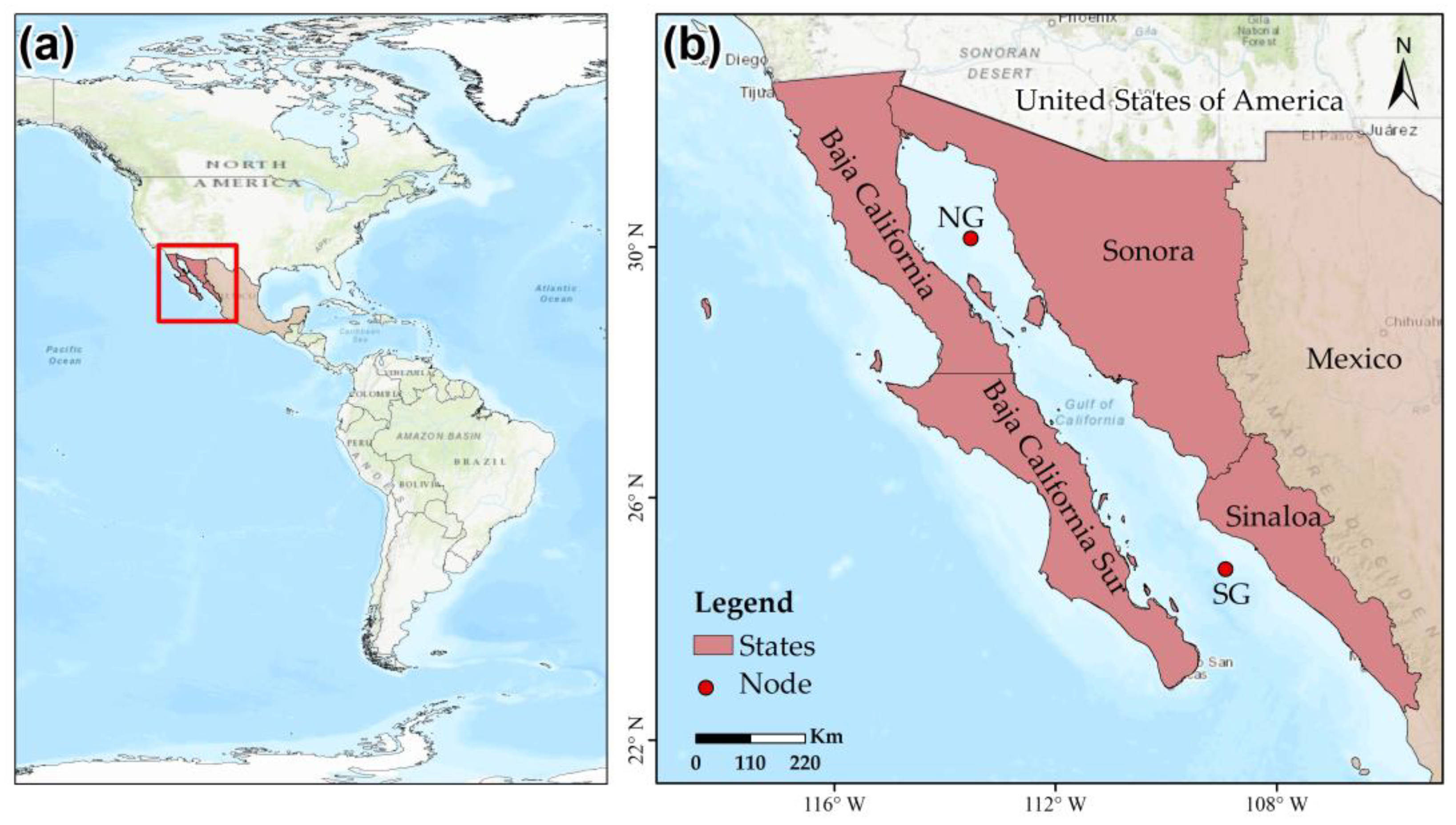

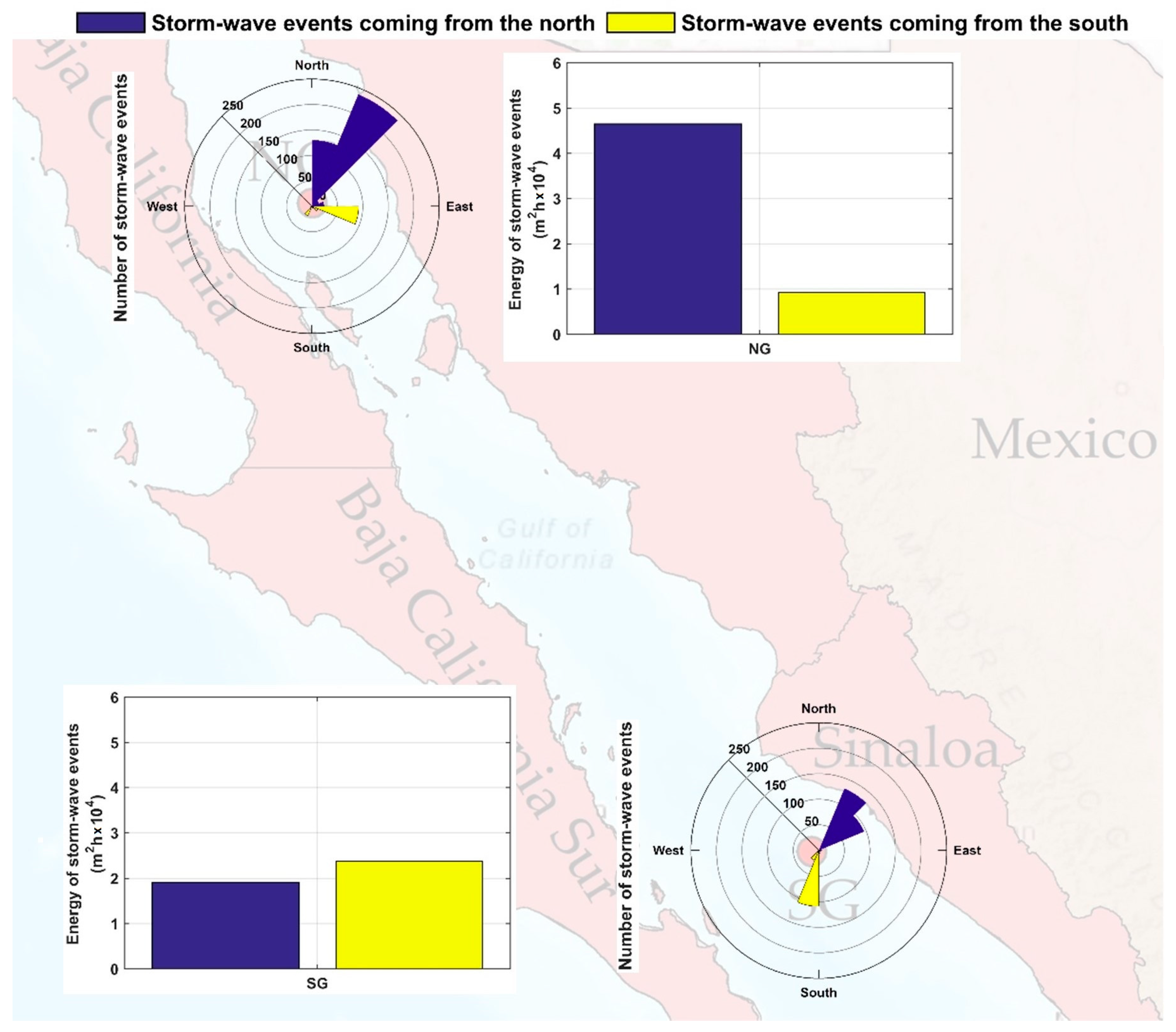
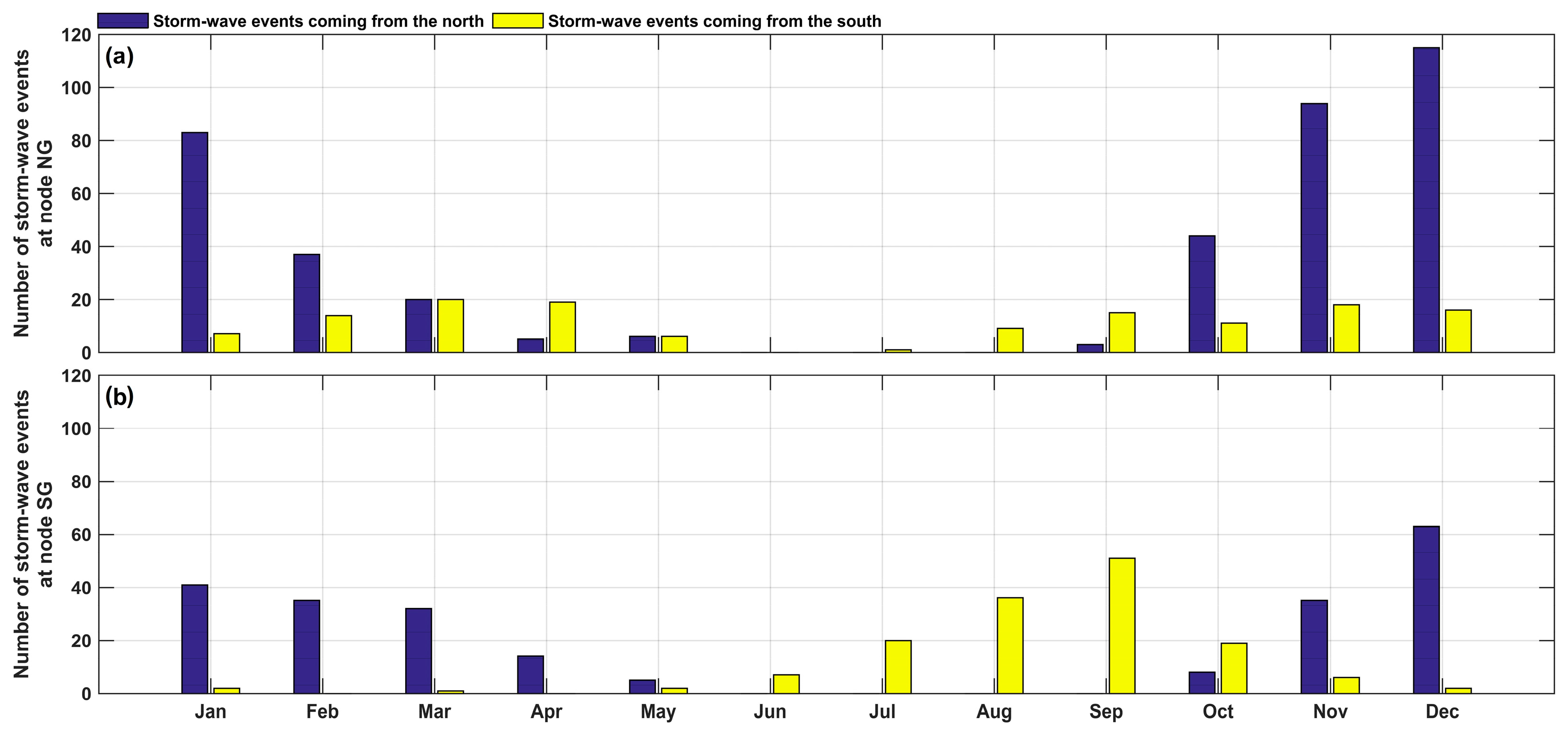
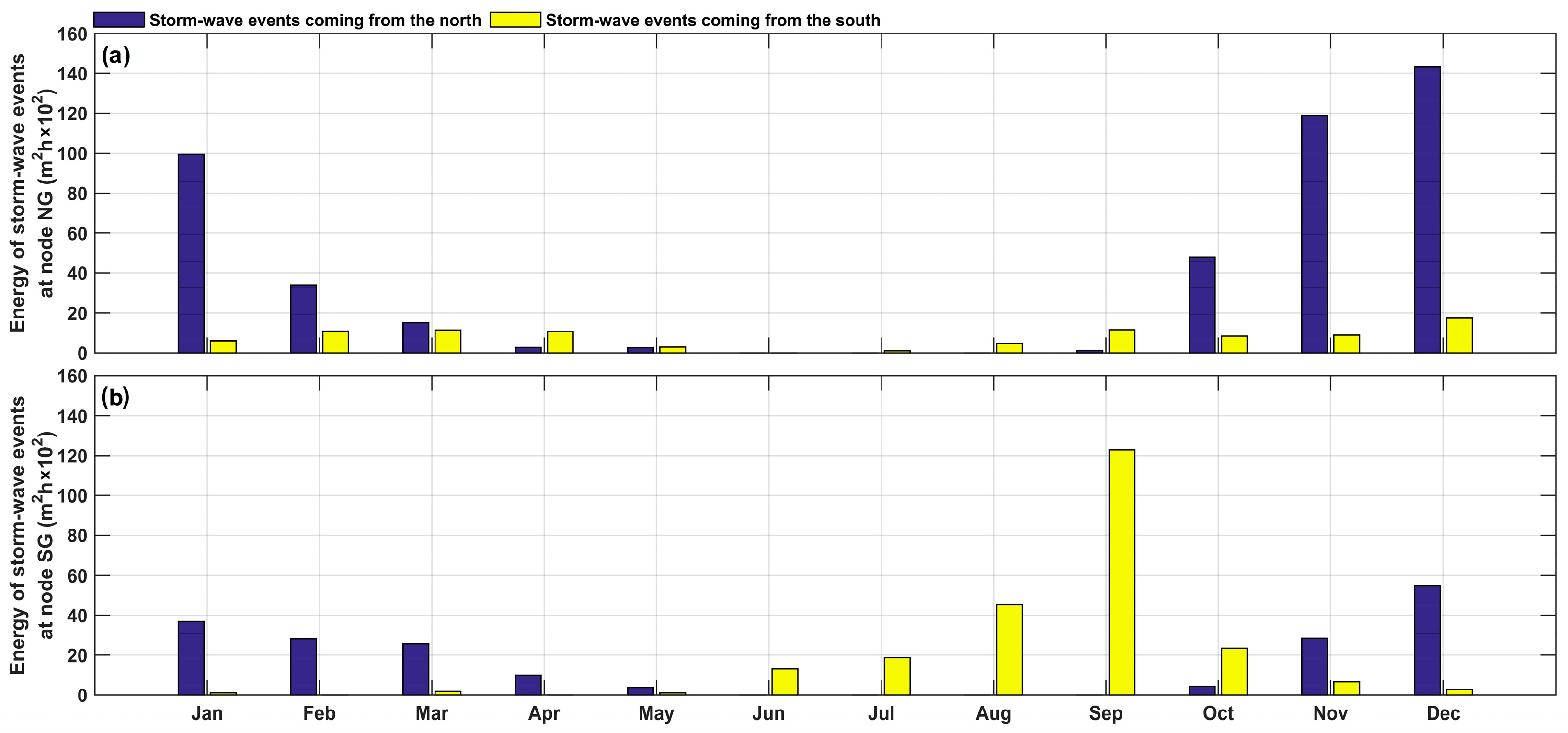
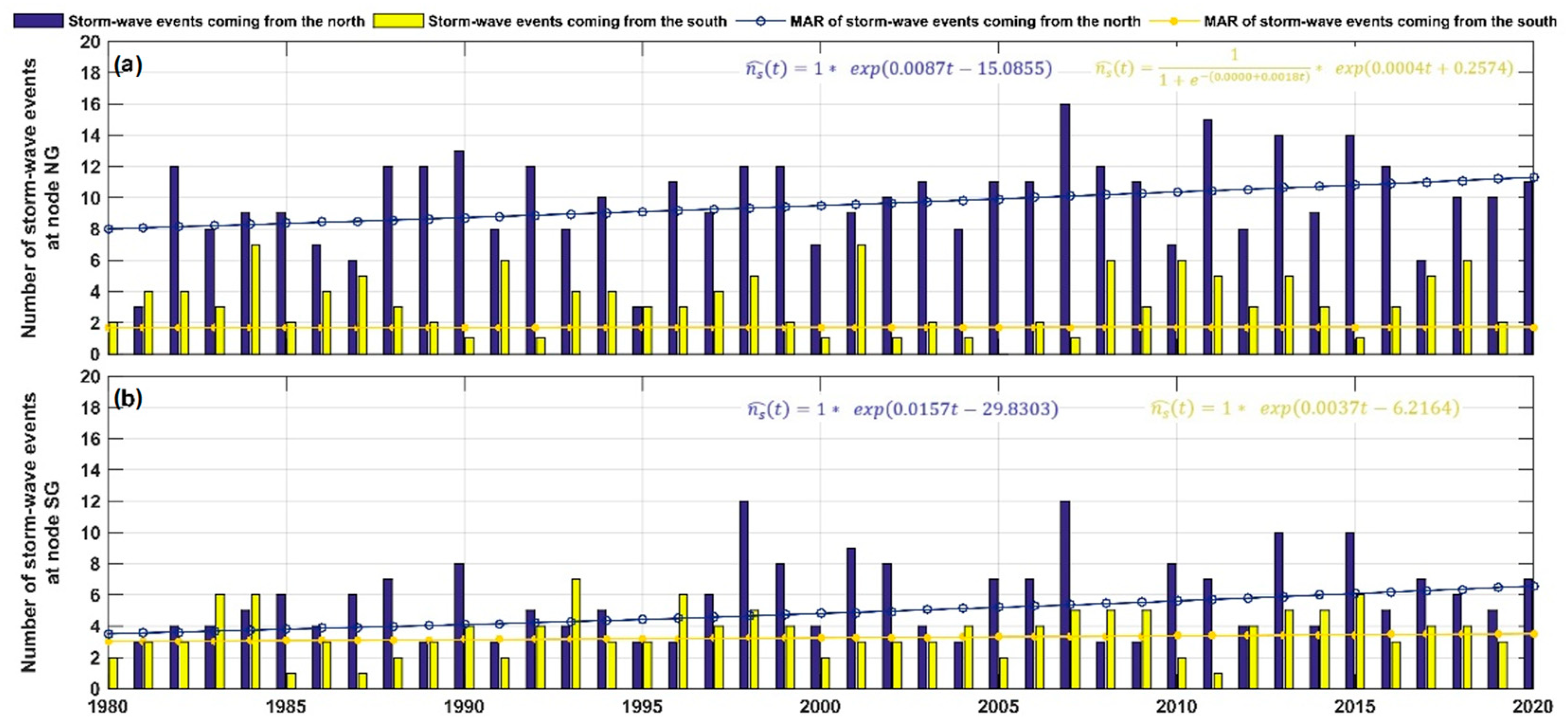
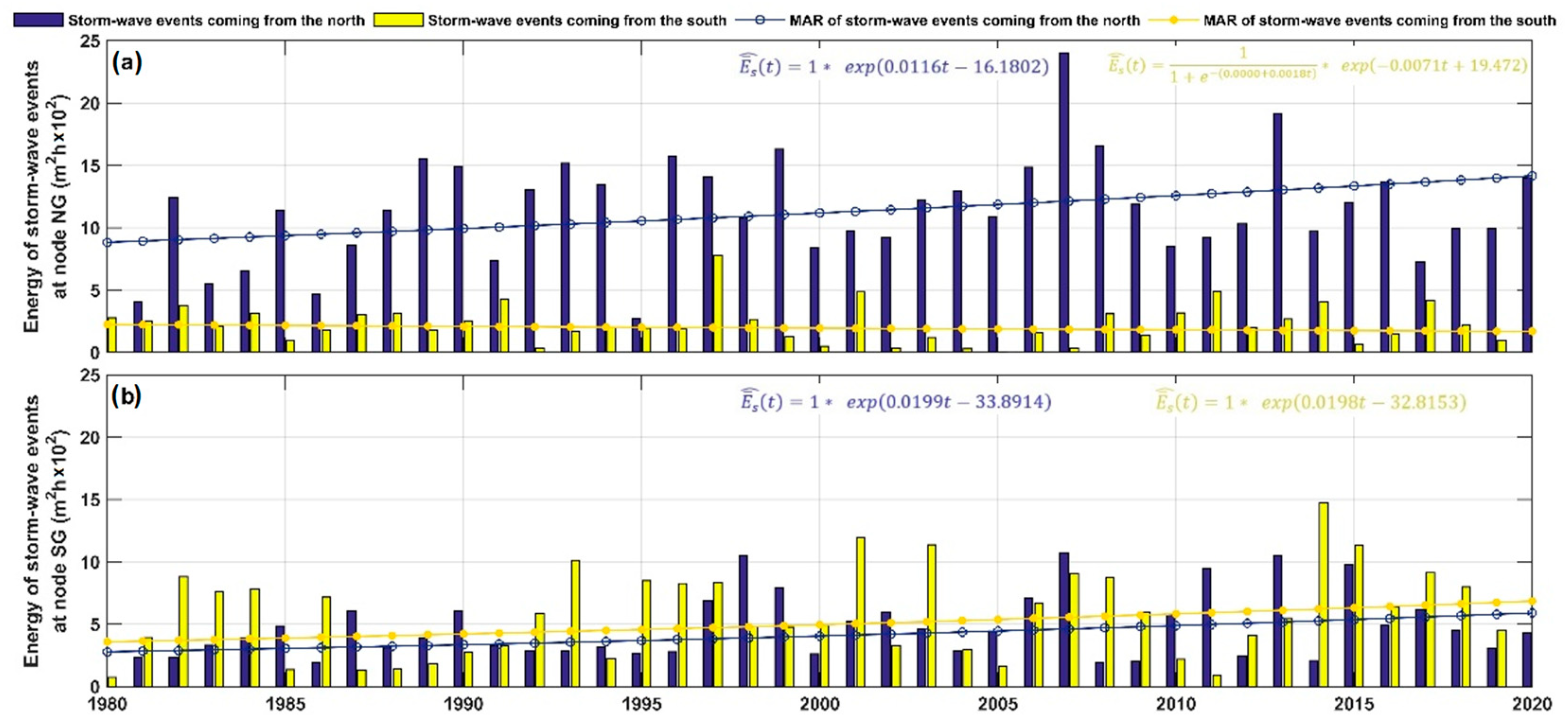
| Node | % Exceedance | ||
|---|---|---|---|
| NG | 1.01 | 1.40 | 3.82 |
| SG | 1.19 | 1.48 | 5.31 |
| Node | Storm-Waves Coming from the North | Storm-Wave Coming from the South | ||
|---|---|---|---|---|
| NG | 9.90 | 114 m2h | 3.30 | 69 m2h |
| SG | 5.70 | 82 m2h | 3.60 | 162 m2h |
Disclaimer/Publisher’s Note: The statements, opinions and data contained in all publications are solely those of the individual author(s) and contributor(s) and not of MDPI and/or the editor(s). MDPI and/or the editor(s) disclaim responsibility for any injury to people or property resulting from any ideas, methods, instructions or products referred to in the content. |
© 2025 by the authors. Licensee MDPI, Basel, Switzerland. This article is an open access article distributed under the terms and conditions of the Creative Commons Attribution (CC BY) license (https://creativecommons.org/licenses/by/4.0/).
Share and Cite
Franco-Ochoa, C.; Zambrano-Medina, Y.G.; Monjardin-Armenta, S.A.; Rentería-Guevara, S.A. Long-Term and Seasonal Analysis of Storm-Wave Events in the Gulf of California. Climate 2025, 13, 54. https://doi.org/10.3390/cli13030054
Franco-Ochoa C, Zambrano-Medina YG, Monjardin-Armenta SA, Rentería-Guevara SA. Long-Term and Seasonal Analysis of Storm-Wave Events in the Gulf of California. Climate. 2025; 13(3):54. https://doi.org/10.3390/cli13030054
Chicago/Turabian StyleFranco-Ochoa, Cuauhtémoc, Yedid Guadalupe Zambrano-Medina, Sergio Alberto Monjardin-Armenta, and Sergio Arturo Rentería-Guevara. 2025. "Long-Term and Seasonal Analysis of Storm-Wave Events in the Gulf of California" Climate 13, no. 3: 54. https://doi.org/10.3390/cli13030054
APA StyleFranco-Ochoa, C., Zambrano-Medina, Y. G., Monjardin-Armenta, S. A., & Rentería-Guevara, S. A. (2025). Long-Term and Seasonal Analysis of Storm-Wave Events in the Gulf of California. Climate, 13(3), 54. https://doi.org/10.3390/cli13030054







